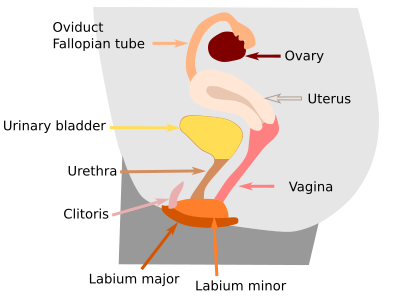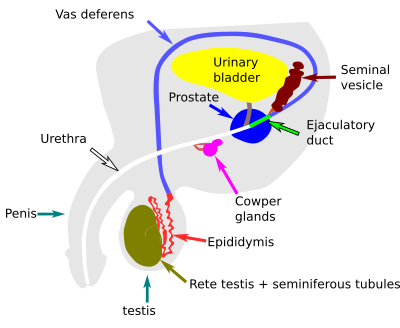The reproductive system has multiple functions in animals. The most important one is the production of gametes, haploid cells specialized in the transmission of genetic information. Male gametes are the sperm cells, and female gametes are the egg cells (ovum). The fusion of one sperm cell and one egg, process known as fertilization, results in a diploid cell known as the zygote. One zygote divides and gives rise to many cell lineages that, after differentiation, form a complete new organism.
The reproductive system is morphologically different in males compared to females. The differences arise very early during embryonic development. Building male or female reproductive structures will later determine the morphological features of the adult animal, mainly the sexual secondary features like muscle development, bone structures, body hair, mammary structures, fat distribution, behavior, etcetera. This is so-called sexual dimorphism. Being male or female is mostly determined by the sexual chromosomes. In humans, XX sexual chromosomes give female morphology, and XY chromosomes give male morphology; that is, they are responsible for the formation of a male or a female reproductive system. However, environmental variables, like temperature, may determine the sex of the animal in some species of fish and reptiles. Moreover, some fish species may behave as hermaphrodites, so they can produce male and female gametes.
The reproductive system consists of several parts: gonads, ducts, vesicles, and reproductive organs.
1. Female reproductive system
Ovaries are the female gonads (Figure 1). They are a couple of structures that produce the female gametes: the egg cells. Oocytes are immature gametes found inside the ovarian follicles, which are structures made up of somatic cells plus one oocyte. Oocyte maturation takes place within the follicles. Ovaries also synthesize and release female hormones like progesterone and estrogen.

Oviducts (Fallopian tubes or uterine tubes) are the ducts used by the oocyte to go from the ovary to the uterus. If fertilization has occurred in the oviduct, the embryo attaches (implantation) to the wall of the uterus, which is the specialized part of reproductive female ducts where development of the embryo occurs in mammals. The walls of the uterus undergoe periodic changes influenced by hormones (estrogens) released by the ovary every time an oocyte is released from its follicle. The vagina is the last part of the female reproductive ducts, connects the uterus with the exterior, and is the receptacle of the male reproductive organ.
The vulva is the external reproductive female organ. It is formed by skin folds known as labia. The clitoris, the main structure for sexual stimulation, is located in the most rostral part of the vulva.
2. Male reproductive system
Testicles are the male gonads (Figure 2). They produce sperm cells, the male gametes, and release testosterone, which is a male hormone. Unlike ovaries, testicles are included in a bag of tissue known as scrotum, located outside the abdominal cavity. The seminiferous tubules are the testicular structures in charge of producing sperm cells. These ducts are made up of somatic cells that form an outer layer of tissue enclosing the germinal cells, which produce gametes by meiosis.

Sperm cells are produced in the seminiferous tubules, and collected and conducted by the epididymis ducts (there are two epididymis ducts, one per testicle). The epididymis connects with the deferent ducts. Ejaculatory ducts continue after the deferent ducts, and they converge into the urethra, which has an open end and allows the gametes to leave the body.
Seminal vesicles and prostate are glands associated with the ejaculatory ducts and urethra, respectively. They release the liquid solution that, together with sperm cells, forms the semen. Cowper glands, or bulbourethral glands, release a fluid for lubrication during sexual arousal.
The male reproductive organ is known as the penis. It is composed of spongy and cavernous bodies and the glans. The urethra runs through the interior of the penis and conducts the semen to the exterior of the body. The urethra is also used by the excretory system for releasing urine.
 Lymphatic
Lymphatic 